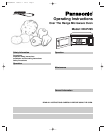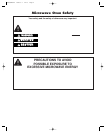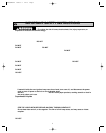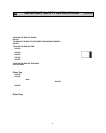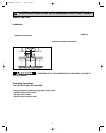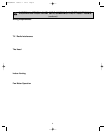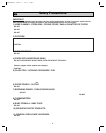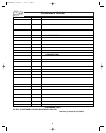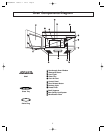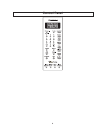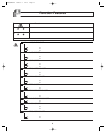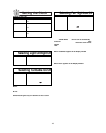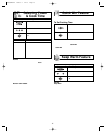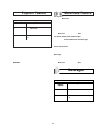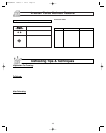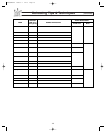
5
Follow These Safety Precautions When Cooking in Your Oven.
IMPORTANT
Proper cooking depends upon the power, the time setting and quantity of food. If you use a smaller portion
than recommended but cook at the time for the recommended portion, fire could result.
1) HOME CANNING / STERILIZING / DRYING FOODS / SMALL QUANTITIES OF FOODS
• DO NOT use your oven for home canning. Your oven cannot maintain the food at the proper canning temperature.
The food may be contaminated and then spoil.
• DO NOT use the microwave oven to sterilize objects (baby bottles, etc.). It is difficult to keep the oven at the high
temperature needed for sterilization.
• DO NOT dry meats, herbs, fruits or vegetables in your oven. Small quantities of food or foods with low moisture
content can dry out, scorch or catch on fire if overheated.
2) POPCORN
Popcorn may be popped in a microwave oven corn popper. Microwave popcorn which pops in its own package is
also available. Follow popcorn manufacturers’ directions and use a brand suitable for the cooking power of your
microwave oven.
CAUTION: When using pre-packaged microwave popcorn, you can follow recommended package instructions or
use the popcorn pad (refer to page 12). Otherwise, the popcorn may not pop adequately or may ignite and cause a
fire. Never leave oven unattended when popping popcorn. Allow the popcorn bag to cool before opening, always
open the bag facing away from your face and body to prevent steam burns.
3) DEEP FAT FRYING
• DO NOT deep fat fry in your microwave oven. Cooking oils may burst into flames and may cause damage to the
oven and perhaps result in burns. Microwave utensils may not withstand the temperature of the hot oil, and can
shatter or melt.
4) FOODS WITH NONPOROUS SKINS
• DO NOT COOK/REHEAT WHOLE EGGS, WITH OR WITHOUT THE SHELL. Steam buildup in whole eggs may
cause them to explode, and possibly damage the oven or cause injury. Reheating SLICED hard-boiled eggs and
cooking SCRAMBLED eggs is safe.
• Potatoes, apples, whole squash and sausages are examples of foods with nonporous skins. These types of
foods must be pierced before microwave cooking to prevent them from exploding.
CAUTION: Cooking dry or old potatoes can cause fire.
5) GLASS TRAY / COOKING CONTAINERS / FOIL
• Cooking containers get hot during microwaving. Heat is transferred from the HOT food to the container and the
Glass Tray. Use pot holders when removing containers from the oven or when removing lids or plastic wrap covers
from cooking containers, to avoid burns.
• The Glass Tray will get hot during cooking. It should be allowed to cool before handling or before paper products,
such as paper plates or microwave popcorn bags, are placed in the oven for microwave cooking.
• When using foil in the oven, allow at least 1-inch (2.5 cm) of space between foil and interior oven walls or door.
• Dishes with metallic trim should not be used, as arcing may occur.
6) PAPER TOWELS / CLOTHS
• DO NOT use paper towels or cloths which contain a synthetic fiber woven into them. The synthetic fiber may cause
the towel to ignite. Use paper toweling under supervision.
7) BROWNING DISHES / OVEN COOKING BAGS
• Browning dishes or grills are designed for microwave cooking only. Always follow instructions provided by the manu-
facturer. DO NOT preheat browning dish more than 6 minutes.
• If an oven cooking bag is used for microwave cooking, prepare according to package directions. DO NOT use a
wire twist-tie to close bag, instead use plastic ties, cotton string or a strip cut from the open end of the bag.
8) THERMOMETERS
• DO NOT use a conventional meat thermometer in your oven. Arcing may occur. Microwave safe thermometers are
available for both meat and candy.
9) BABY FORMULA / BABY FOOD
• DO NOT heat baby formula or baby food in the microwave oven. The glass jar or surface of the food may appear
warm while the interior can be so hot as to burn the infant’s mouth and esophagus.
10) REHEATING PASTRY PRODUCTS
• When reheating pastry products, check temperatures of any fillings before eating. Some foods have fillings which
heat faster and can be extremely hot, while the surface remains warm to the touch (ex. Jelly Donuts).
11) GENERAL OVEN USAGE GUIDELINES
• DO NOT use the oven for any purpose other than the preparation of food.
Safety Precautions
F00036Z01AP 2006.3.1 12:13 Page 7



